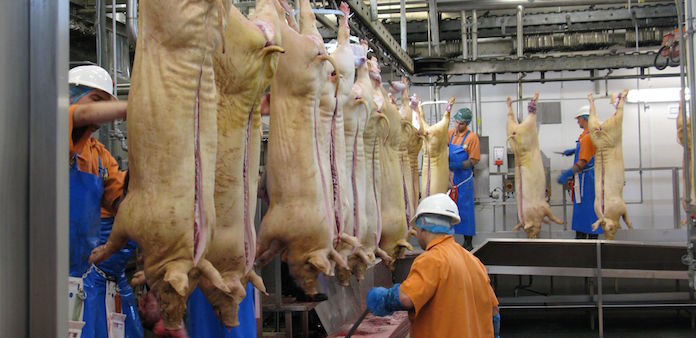While 2017 brought a welcome return to profitability in the marketplace, 2018 looks set to be more challenging for pig producers on the back of rising domestic and global production.
The EU-spec SPP reached a record high of 164.75p/kg in July, following 16 months of virtually uninterrupted growth. AHDB’s average producer margin figure of +27p/kg in the third quarter of 2017 was the highest since records began.
AHDB analyst Bethan Wilkins said: “At the start of 2017, tight supplies supported prices. A similar situation in Europe, coupled to the weakness of the pound, also limited import competitiveness. Meanwhile, export demand for UK pork remained good, despite overall weaker Chinese demand.”
But prices have slipped since then, falling back to 151p/kg towards the end of the year, as supplies have become more plentiful. Abattoir unreliability has created further challenges, escalating carcase weights and adding to increasing pork supplies, Ms Wilkins added.
“The situation has shifted in recent months, and the outlook seems less buoyant for 2018,” she said.
Despite the plant reliability issues, production was expected to top 2016 levels in the fourth quarter of 2017, topping 230,000 tonnes.
AHDB forecasts anticipate continued expansion in 2018, with domestic production potentially reaching 925,0000 tonnes, which would be the highest level since 1999.
“This follows some recovery in sow numbers, improvements to productivity and increasing finishing weights. As such, it is unlikely prices in 2018 will reach the highs seen this year,” Ms Wilkins said.
Defra June 2017 Census figures, published in late-December, supported forecasts of rises in domestic pig production in 2018. Key findings included:
- A 2.1% increase in overall UK pig numbers to nearly 5m
- A 0.4% increase in the female breeding herd to 417,000
- A 2.6% increase in gilts for first time breeding to 81,000
- A 2.3% increase in fattening pigs to 4.5m
Expanding global production is also expected to challenge UK exports and increase import pressure. Following an estimated 1% increase in world pigmeat production in 2017, the US Department of Agriculture is forecasting a further 2% rise in 2018, driven mainly by China.
There are some positive signs, however. UK pork exports have held up in China this year, despite the general downturn, and it is hoped this will continue.
There are also signs that domestic demand is turning a corner, with figures from Kantar WorldPanel showing year-on-year pork sales rising across the board despite higher prices, in the 12 weeks to December 3, supported, it seems, by the Midweek Meal marketing campaign.
“Any strengthening in demand would help support the market as supplies increase in 2018,” Ms Wilkins said.
Brexit uncertainty
In its 2018 Outlook, Andersons Farm Business Consultants concluded, with little signs of a sustained strengthening of sterling, pig producers can ‘remain optimistic going into 2018 of relatively high prices being sustained’.
But in the longer term, the outlook is ‘uncertain’, with the most important factor being our future trading relationship with the EU and questions over tariff-free trade.
“If the UK and the EU retain tariff-free access to each other’s markets after Brexit, then output price dynamics would be relatively unaffected. If no such deal is concluded, then trading between the two will default to WTO rules, which would have a significant impact on the pig industry,” the report says.
UK producers would have an opportunity to displace EU imports, which would become less competitiveness under these conditions, although this would require and increase in domestic production, which is only 54% self-sufficient in pigmeat. This could run into problems of carcase balance, however, as the UK pig sector would need to find new markets, for example in China and other Asian countries, for shoulders and offal, as it supplied more loins and legs domestically.
The other flip side is that the UK would need to establish Free Trade Arrangements further afield, potentially exposing the UK to floods of cheap imports, putting severe pressure on UK producers.
“The industry needs to redouble the efforts of recent years to raise the profile of of quality assured British pork and thus help build non-tarriff barriers to imports.”




